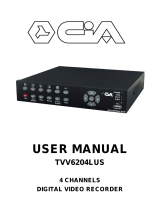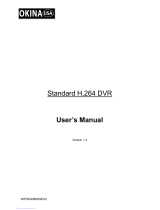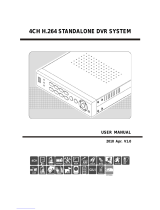Page is loading ...

TruVision DVR 41 User
Manual
P/N 1072566C-EN • REV 1.0 • ISS 22MAR13

Copyright
©
2013 UTC Fire & Security Americas Corporation, Inc.
Interlogix is part of UTC Climate Controls & Security, a unit of United
Technologies Corporation. All rights reserved
.
Trademarks and
patents
The TruVision and I
nterlogix names and logos are trademarks of United
Technologies.
Other trade names used in this document may be trademarks or registered
trademarks of the manufacturers or vendors of the respective products.
Manufacturer
UTC Fire & Security Americas Corp
oration, Inc.
2955 Red Hill Avenue, Costa Mesa, CA 92626
-5923, USA
Authorized EU manufacturing representative:
UTC Fire & Security B.V.
Kelvinstraat 7, 6003 DH Weert, The Netherlands
Certification
N4131
FCC compliance
Class B:
This equipment has be
en tested and found to comply with the limits for
a Class B digital device, pursuant to part 15 of the FCC Rules. These limits are
designed to provide reasonable protection against harmful interference in a
residential installation. This equipment generate
s, uses, and can radiate radio
frequency energy and, if not installed and used in accordance with the
instructions, may cause harmful interference to radio communications.
There is no guarantee that interference will not occur in a particular installation.
If this equipment does cause harmful interference to radio or television
reception, which can be determined by turning the equipment off and on, the
user is encouraged to try to correct the interference by one or more of the
following measures:
•
Reorient or relocate the receiving antenna.
•
Increase the separation between the equipment and receiver.
•
Connect the equipment into an outlet on a circuit different from that to which
the receiver is connected.
•
Consult the dealer or an experienced radio/TV technician for help.
European Union
directives
12004/108/EC (EMC directive):
Hereby, UTC Fire & Security declares that this
device is in compliance
or with the essential requirements and other relevant
provisions of Directive 2004/108/EC
.
2002/96/EC (W
EEE directive): Products marked with this symbol cannot be
disposed of as unsorted municipal waste in the European Union. For proper
recycling, return this product to your local supplier upon the purchase of
equivalent new equipment, or dispose of it at de
signated collection points. For
more information see: www.recyclethis.info.
2006/66/EC (battery directive):
This product contains a battery that cannot be
disposed of as unsorted municipal waste in the European Union. See the
product documentation for
specific battery information. The battery is marked
with this symbol, which may include lettering to indicate cadmium (Cd), lead
(Pb), or mercury (Hg). For proper recycling, return the battery to your supplier or
to a designated collection point. For more
information see: www.recyclethis.info.
Contact information
For contact information
, see www.utcfireandsecurity.com or
www.utcfssecurityproducts.eu

TruVision DVR 41 User Manual i
Content
Chapter 1 Product introduction 1
Product overview 1
Chapter 2 Installation 3
Installation environment 3
Unpacking the TVR 41 and its accessories 3
Back panel 4
PTZ dome camera set up 5
Wiring the keypad 10
RS-485 ports 12
RS-232 port 13
Monitor connections 13
Loop through 13
Audio inputs and output 13
Brackets 14
Chapter 3 Getting started 15
Turning on and off the DVR 15
Using the setup wizard 16
Chapter 4 Operating instructions 19
Controlling the TVR 41 19
Using the front panel 19
Using the mouse 21
Using the IR remote control 22
Menu overview 25
Chapter 5 Live view 29
Description of live view 29
Video output 29
Audio output 30
Controlling live view 30
Multiview format 32
Sequencing cameras 33
Accessing frequently used commands 34
Configuring live view 35
Configuring time and date 38
General settings 39
V-stream encoding 42
Chapter 6 Controlling a PTZ camera 43
Configuring PTZ settings 43
Calling up presets, tours and shadow tours 44
Setting and calling up presets 45

ii TruVision DVR 41 User Manual
Setting and calling up preset tours 47
Setting and calling up a shadow tour 48
Chapter 7 Playing back a recording 51
Overview of the playback window 51
Playback pop-up menu 54
Instant playback 54
All-day playback 55
Searching recorded video 56
Playing back recordings by time and video type 57
Playing back recordings by event 58
Creating and playing back bookmarked recordings 59
Slideshow of snapshots 60
Playing back recordings from the system log 60
Playback skip time 61
Motion search 62
Playing back frame-by-frame 62
Digital zoom in playback 63
Chapter 8 Archiving recorded files 65
Archiving files 65
Auto archiving 68
Creating and archiving video clips 69
Archiving snapshots 69
Managing backup devices 70
Playing back archived files on a PC 70
Chapter 9 Using the web browser 71
Windows Vista and 7 users 71
Accessing the web browser 72
Web browser overview 72
Using the web browser to configure the device 74
Searching and playing back recorded video 77
Searching for event logs 79
Dual streaming 80
Controlling a PTZ dome camera in the web browser 81
Capturing text insertions 81
Text overlay 83
Using a network storage system 84
Chapter 10 Recording 87
Initializing recording settings 87
Defining a recording schedule 90
Daily schedules 91
Holiday schedules 92
Manual recording 93
Motion detection schedules 93
External alarm schedules 93

TruVision DVR 41 User Manual iii
Protecting recorded files 94
HDD redundancy 95
Chapter 11 Alarm settings 97
Description of alarm notification types 97
Setting up motion detection 100
Setting up external alarms 102
Triggering or clearing alarm outputs manually 104
Setting up system notifications 105
Detecting video loss 105
Detecting video tampering 106
Chapter 12 Network settings 109
Configuring general network settings 109
Configuring PPPoE 110
Configuring DDNS 111
Configuring an NTP server 112
Configuring e-mail 112
Configuring UPnPTM 113
Configuring SNMP 115
Configuring an FTP server to store snapshots 115
Configuring a remote alarm host 115
Configuring multicast 116
Configuring the server and HTTP ports 116
Configuring the RTSP service port 116
Checking network status 117
Exporting network packet data 118
Bandwidth throttle management 118
Chapter 13 HDD management 121
Initializing HDDs 121
Controlling disk space on the HDD 121
Setting up HDD groups 122
Recording dual streaming 123
Setting the HDD property 123
Checking HDD status 124
Configuring HDD alarms 124
Managing eSATA 125
Checking the S.M.A.R.T. information 125
Searching video using disk analysis 126
Chapter 14 Camera settings 129
Configuring the camera OSD settings 129
Setting up privacy masking 130
Adjusting camera image settings 131
Hiding a camera image from view 131

iv TruVision DVR 41 User Manual
Chapter 15 DVR management 133
Configuring the RS-232 port 133
Updating system firmware 134
Restoring default settings 135
Viewing system information 136
Searching system logs for events 137
Importing and exporting configuration settings 138
Chapter 16 User management 139
Adding a new user 139
Customizing a user’s access privileges 140
Deleting a user 141
Modifying a user 142
Changing the Admin password 142
Chapter 17 iTVRmobile 143
Setup and login 143
Live view 144
Controlling a PTZ camera 145
Device management 146
Favorites 147
Local configuration 148
Change passwords 148
Snapshots 148
Appendix A Specifications 149
Appendix B PTZ protocols 151
Appendix C Port forwarding information 153
Appendix D KTD-405 keypad 155
Supported firmware 155
Wiring the keypad 155
Setting up the keypad to work with the TVR 41 156
Operating the keypad 158
Appendix E Maximum pre-recording times 163
Appendix F Supported PTZ commands 165
Appendix G Default menu settings 167
Index 177

TruVision DVR 41 User Manual 1
Chapter 1
Product introduction
Product overview
This is the TruVision DVR 41(TVR 41) User Manual for models:
Table 1: Product codes
Americas
EMEA
TVR
-4108-2T TVR-4104-1TEA
TVR
-4108-4T TVR-4104-2TEA
TVR
-4116-2T TVR-4108-2TEA
TVR
-4116-4T TVR-4108-4TEA
TVR
-4116-8T TVR-4116-2TEA
TVR
-4116-12T TVR-4116-4TEA
TVR-4116-8TEA
TVR-4116-12TEA
Note: Models are shipped with the power chords for their region.
For regions not listed in Table 1 above, please contact your local supplier.
The TruVision™ DVR 41 (TVR 41) is a versatile, user-friendly embedded digital
video recorder (DVR) allowing end-users to record 4, 8, or 16 analog cameras at
4 CIF in real time (25/30 fps), while providing integration with the UTC portfolio of
security solutions, and offering a seamless product experience within the
TruVision brand.
Its dual streaming functionality allows the user to set up different settings for
recording and streaming video in live view mode.
TruVision DVR 41 can fully integrate with the license-free TruVision Navigator
software, which is ideal for the most commercial applications. TVR 41’s easy and
intuitive-to-use web browser interface enables remote configuration and secure
viewing, searching, and playing back of video from computers connected via the
Internet.

0BChapter 1: Product introduction
2 TruVision DVR 41 User Manual

TruVision DVR 41 User Manual 3
Chapter 2
Installation
This section describes how to install the TVR 41 unit.
Installation environment
When installing your product, consider these factors:
• Ventilation
• Temperature
• Moisture
• Chassis load
Ventilation: Do not block any ventilation openings. Install in accordance with the
manufacturer’s instructions. Ensure that the location planned for the installation
of the unit is well ventilated.
Temperature: Consider the unit’s operating temperature (-10 to +55 ºC, 14 to
131 °F) and noncondensing humidity specifications (10 to 90%) before choosing
an installation location. Extremes of heat or cold beyond the specified operating
temperature limits may reduce the life expectancy of the DVR. Do not install the
unit on top of other hot equipment. Leave 44 mm (1.75 in.) of space between
rack-mounted TruVision DVR 41 units.
Moisture: Do not use the unit near water. Moisture can damage the internal
components. To reduce the risk of fire or electric shock, do not expose this unit to
rain or moisture.
Chassis: Equipment weighing less than 15.9 kg (35 lb.) may be placed on top of
the unit.
Unpacking the TVR 41 and its accessories
When you receive the product, check the package and contents for damage, and
verify that all items are included. There is an item list included in the package. If
any of the items are damaged or missing, please contact your local supplier.

1BChapter 2: Installation
4 TruVision DVR 41 User Manual
Items shipped with the product include:
• IR (infrared) remote control
• Two AAA batteries for the remote control
• AC power cords (US, Europe, UK)
• USB mouse
• DVR
• Video loop through cable
• CD with software and manuals
• TruVision DVR 41 Quick Start Guide
• TruVision DVR 41 User Manual (on CD)
Back panel
Figure 1 on page 5 shows the back panel connections and describes each
connector on a typical TVR 41 digital video recorder. Details may vary for specific
models.
Before powering up the DVR, connect the cameras and a main monitor for basic
operation.

1BChapter 2: Installation
TruVision DVR 41 User Manual 5
Figure 1: Back panel connections
1. Connect up to 16 analog cameras to BNC
connectors.
2. Connect audio inputs (available for each
camera) to RCA connectors.
3. Connect up to two CCTV monitors (BNC-
type connectors):
- Spot monitor
- Main monitor
4. Connect to speakers for audio output.
5. Connect RCA connector to a microphone.
6. Connect to a RS-232 device.
7. Connect to a VGA monitor.
8. Connect to an optional eSATA device such
as SATA HDD, CD/DVD-RM.
9. Connect to a HDTV. The HDMI connection
supports both digital audio and video.
10. Connect to an optional USB device such as
a mouse, CD/DVD burner or HDD. The
DVR supports both a USB DVD and a USB
HD on the front and back USB ports.
11. Connect to a network.
12. Terminate the line to the dome cameras
using this RS-485 switch. Default is Off.
13. Connect to a PTZ control.
14. Connect to a keyboard (KTD-405 shown)
15. Connect up to 16 alarm input cables to
relay outputs.
16. Connect up to four alarm relay outputs.
17. Connect to ground.
18. Connect to a power supply.
19. Loop through for up to 16 analog cameras
(see item 1).
PTZ dome camera set up
Use the USB mouse provided or the optional keypad for local telemetry control. If
using the TVR 41 over a network, use the web browser to control the PTZ dome
cameras or TruVision Navigator.
See Appendix B on page151 for the supported protocols and Appendix F on
page 165 for the PTZ commands supported by each protocol.

1BChapter 2: Installation
6 TruVision DVR 41 User Manual
Each PTZ camera must be set up individually. For information on configuring
PTZ dome camera settings, see Chapter 6, “Controlling a PTZ camera” on page
43.
Connecting a TVR 41 to a PTZ dome camera and a
keypad
Use the input/output box that is supplied with the keypad to connect a keypad to
the TVR 41. The keypad can be connected to a PTZ camera for local control or
for control over the network.
See Figure 2 below for the preferred setup. Any PTZ dome camera can be
controlled as the DVR is doing the PTZ protocol translation. However, this setup
provides only limited dome configuration.
Figure 2: Connecting a keypad to the TVR 41 for control of a PTZ dome camera over the
network
Configuring the PTZ protocols for Interlogix cameras
Before the PTZ dome cameras are assembled in their housings, set their
protocol and address DIP switches for the TVR 41. See Table 2 on page 7 for
different Interlogix PTZ dome camera settings.
If you are using PTZ dome cameras from another company, please refer to their
configuration instructions.

1BChapter 2: Installation
TruVision DVR 41 User Manual 7
Table 2: PTZ protocols for Interlogix cameras
Camera
Switch setting
TruVision Mini PTZ
12X: Indoor Dome
Protocol DIP
switches: 000000
1. Protocol DIP switches
2. RS-485 communication DIP switches
3. Camera ID DIP switches
RS-485
communication DIP
switches:
0000000000
Camera ID DIP
switches: Select the
camera ID
DIP switch
address as
required
RS-485 data connector:
TruVision Mini PTZ
12X: O
utdoor
Dome
Protocol DIP
switches: 000000
1. Protocol DIP switches
2. RS-485 communication DIP switches
3. Camera ID DIP switches
RS-485
communication DIP
switches:
0000000000
Camera ID DIP
switches: Select the
camera ID
DIP switch
address as
required.
RS-485 data connector:

1BChapter 2: Installation
8 TruVision DVR 41 User Manual
Camera
Switch setting
TruVision Dome
16X PTZ
Protocol switches: 0111
1. Address switches; 2. Baud switches;
3. Protocol switches
Address switches: Select the
camera ID
DIP switch
address as
required.
Baud rate: 0000
RS-485 data connector:
CyberDome
Protocol switches: NA
Address switches: Select the
camera ID
DIP switch
address as
required.
RS-485 data connector:

1BChapter 2: Installation
TruVision DVR 41 User Manual 9
Camera
Switch setting
UltraView PTZ
Protocol switches: 01000
1. Protocol switches;
2. Address switches
Address switches: Select the
switch
address as
required.
RS-485 data connector:
Legend
Protocol switches: 1
Address switches: Select the
camera ID
DIP switch
address as
required.
RS-485 data connector:

1BChapter 2: Installation
10 TruVision DVR 41 User Manual
Wiring the keypad
The keypad uses RS-485 simplex wiring. The signal is transferred by a single
twisted pair line. A shielded STP CAT5 network cable is recommended. Ground
one end of the cable, either the first or last device on the RS-485 line.
The maximum number of devices that can be installed in one bus is 255, with a
maximum cable length of 1200 m. The cable length can be expanded using a
signal distributor.
Both the first and the last device in series should be terminated with 120 Ohm
resistance to minimize line reflections. See Figure 3 below.
Figure 3: RS-485 bus serial wiring (KTD-405 keypad shown)
1. Keypad
2. I/O box
3. See section “RS-485 ports” on page 12
Use an RS-485 signal distributor for a star wiring configuration. See Figure 4 on
page 11.

1BChapter 2: Installation
TruVision DVR 41 User Manual 11
Figure 4: Star wiring with RS-485 signal distributor
Correct:
1. Keypad
2. I/O box
3. RS-485 distributor
4. See section “RS-485 ports” on page 12
Incorrect:
1. Keypad
2. I/O box
3. See section “RS-485 ports” on page 12
Use an RS-485 signal distributor to increase the maximum number of devices on
the bus as well as the total range. Each distributor output provides another RS-
485 bus, extending the output an additional 1200 m. Up to 31 TVR 41s can be
connected to each output. See Figure 5 on page 12.

1BChapter 2: Installation
12 TruVision DVR 41 User Manual
Figure 5: Expanding the system with an RS-485 signal distributor
1. Keypad
2. I/O box
3. RS-485 distributor
4. See section “RS-485 ports” below
Caution: Most signal distributors are unidirectional. This means that the signal
only flows from the input towards the outputs. Consequently it is not possible to
connect several keypads.
See section “RS-485 ports” below to configure the RS-485 port communication
settings.
RS-485 ports
There are two RS-485 ports on the back panel of the DVR. See Figure 6 on page
13 for the serial pin outs.
• Dome RS-485:
A and B: Connect pan, tilt, zoom control of PTZ dome cameras. A = +, B = -
C and D: Not used
G: Ground of dome camera
G: Ground of keypad
• Keyb: Connect the keypad.

1BChapter 2: Installation
TruVision DVR 41 User Manual 13
Figure 6: RS-485 pins
RS-232 port
Use the RS-232 port to connect CBR-PB3-POS (point-of-sale) and ATM devices
to the DVR. See “Configuring the RS-232 port” on page 133 to configure the port.
Monitor connections
Connect the monitors to the DVR outputs (BNC/VGA/HMDI). The unit provides a
1 Vp-p CVBS signal. See Figure 1 on page 5 for connecting a monitor to a
TVR 41.
The TVR 41 supports up to 1280 × 1024 / 60 Hz resolution in VGA. The monitor
resolution should be at least 800 × 600. Adjust your monitor accordingly to this
resolution.
Loop through
You can loop through the cameras to equipment such as a matrix, monitors or a
second DVR. There are 16 numbered loop-through BNC outputs. See Figure 1
on page 5.
Audio inputs and output
The unit is equipped with 16 audio inputs and two audio outputs. Both the audio
output and the audio inputs are line-level. Each 16 audio input is associated with
one of the 16 cameras.
Audio input
RCA jack, 315 mV, 40 kohms. Unbalanced
Audio output
RCA jack, 315mV, 600 ohms. Unbalanced
Note: Line-level audio requires amplification.

1BChapter 2: Installation
14 TruVision DVR 41 User Manual
Brackets
The DVR is easily rack-mountable with the purchase of the TVR-RK-1 rack-
mount kit. See Figure 7 below. Contact your local supplier to order it.
Figure 7: Rack-mount installation
Attach the small front rack ears to the unit
(screws supplied) Attach the DVR to the front rails
(screws not included)
To install the racks:
1. Attach the two small front-rack mount ears to the DVR (screws supplied).
2. Attach the two large rear support brackets (not supplied) to the rear rails.
3. Attach the DVR to the front rails (screws not supplied).
Caution:
Do not rack-mount the TVR 41 without the rear rails installed. Failure to install
the rear rails can damage the DVR.
/





